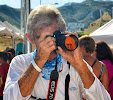
The real question seems to be, do these local, state and national leaders really give a crap? If they did they could simply walk around the marina in Cabo and figure it out for themselves.
Mexican Politicians Ignore Marine Resource Revenue...Again
For many years sport fishermen have been convinced that a substantial portion of the tourist money spent in southern Baja came from the sport fishing visitor. Thanks to The Billfish Foundation (TBF), it is no longer just conjecture. A new report commissioned by TBF presents irrefutable confirmation of the source and amount of money being spent by Los Cabos anglers.
According to the report, fishing in the Los Cabos area, loosely defined as East Cape, San Jose del Cabo, and Cabo San Lucas, is a billion dollar industry!
The TBF study shows that in 2007, 354,013 people, most of whom were international visitors, fished in Los Cabos. While in Los Cabos, they spent an estimated $633.6 million U.S. for lodging, charter boats, food, transportation, tackle, fuel, etc. These expenditures started a series of cascading economic effects in the local economy:
· 24,426 jobs were created
· $245.5 million U.S. was received in local and federal tax revenues
· $ 1.125 billion U.S. went into the total economic activity
“A good way to view these impacts is to consider that, if everyone who fished in Los Cabos had not visited in 2007, the regional economy would have been $1.125 billion U.S. smaller,” said Rob Southwick, lead economist in the research effort.
“That means there would have been 24,426 fewer jobs, and the government coffers would have been poorer by $245.5 million U.S.”
Visitors who fish there provide an estimated 24.1 percent of the total Los Cabos economy. A job is supported for every $18,156 U.S. in retail sales. Dollars spent by anglers generated $1.78 in economic activity in the region and every visiting angler generated $721.99 U.S. in local and federal tax revenues.
In addition, the Los Cabos anglers’ expenditures generated $145 million U.S. to Mexico’s Gross Domestic Product; 10,469 additional jobs were created elsewhere in Mexico and $75 million U.S. in taxes were added to the federal coffers. This income has become a significant provider of jobs and new dollars to Mexico’s economy.
The report revealed that though this area has become a major North American tourist destination in recent years driven heavily by its world-class striped marlin fishery, the most targeted species of interest for sport fishermen were dorado, registering nearly 95% with a success catch rate of over 81%. Marlin was second at nearly 90% with a success rate of over 82% and tuna was the third most popular at over 86% with a 75% success rate among the 10 species listed.
Ironically, the dorado, a species which under Mexican fisheries law is supposed to be strictly relegated for sport fishing, has for years attracted the illegal commercial long-lining and netting interests in the Sea of Cortez (Gulf of California) waters. A controversial new regulation, NOM-029, allows for the “incidental” harvest of billfish, dorado and other species within Mexico’s 24 year-old conservation zones. Recent seizures of illegal dorado catches in the tons has also produced headlines in Mexican newspapers and brought attention to the commercial “fishing mafia.”
TBF has had a presence in the Baja Sur region since 2002. Dr. Russell Nelson, TBF’s chief scientist, along with Guillermo Alvarez, TBF’s Mexican Conservation Director, explained “the independent report was necessary to provide tangible evidence to local, state and national leaders of the economic importance of Los Cabos fisheries.”
The real question seems to be, do these local, state and national leaders really give a crap?
So far in spite of all the best efforts of Marinas de Mexico, The Los Cabos Hotel Association, the many different groups like IGFA, The Billfish Foundation, Seawatch, countless businesses, clubs, communities, tourist organizations, the private sector and interested individuals, the Mexican leadership continues to ignore the importance of protecting the God given resource Mexico enjoys.
The complete report in English and Spanish with all survey results is available online at the TBF web site: www.billfish.org .
My email address is roadtrekker1@verizon.net .






